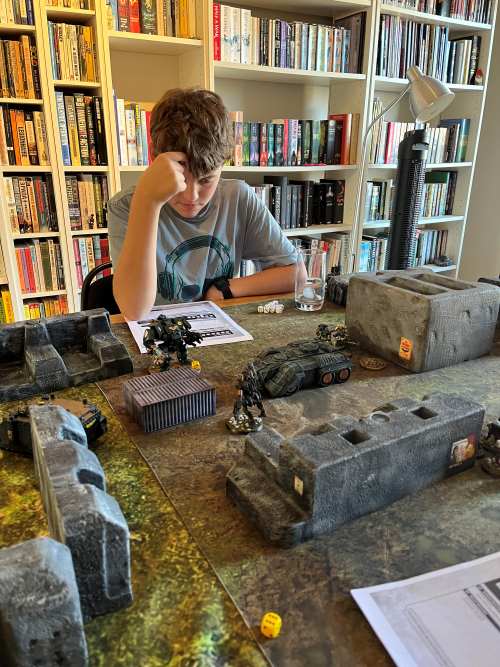When I was in school, one of my favorite pastimes was playing Warhammer 40K. The thrill of painting miniatures and taking them into battle with my friends are memories I always cherish. Life moved on, and like many hobbies from our youth, my 40K collection was boxed up and stored away. Recently, however, my son has discovered the game, and his enthusiasm has reignited my passion for it. Returning to Warhammer 40K has not only brought back fond memories but also reminded me of the many benefits this game offers, both for young players like my son and for those of us (oldies)who are reconnecting with it.
Creativity and Artistic Expression
One of the most rewarding aspects of Warhammer 40K is the opportunity for creativity. Of course, assembling and painting miniatures allows players to express themselves artistically, experimenting with color schemes, customizing models, and even creating their own unique chapters or factions. I’ve never really thought of myself as creative, until my wife pointed out the imagination and innovation that I put into the hobby.
- For Kids: For my son, painting his first Space Marine was an exercise in patience and creativity. It was a chance for him to explore his artistic side and take pride in creating something with his own hands.
- For Adults: Returning to painting after so many years has been incredibly satisfying. It’s a meditative process that lets me unwind and focus on something tangible. Plus, it’s a great way to bond with my son as we share tips and admire each other’s work.
Strategic Thinking and Problem-Solving
Warhammer 40K is as much about strategy as it is about creativity. Every game requires players to think critically about their tactics, anticipate their opponent’s moves, and make decisions that will impact the outcome of the battle.
- For Kids: My son is learning valuable skills in strategic thinking and problem-solving. Interestingly, he’s discovering that winning isn’t just about having the biggest army. Rather, it’s about making smart decisions, understanding the strengths and weaknesses of his units, and planning several steps ahead.
- For Adults: Revisiting the tactical side of the game has been a great mental workout. It’s reminded me of how much fun it is to engage in deep strategic planning, where every move counts and adapting to unexpected situations can turn the tide of a battle.
Social Interaction and Community
Warhammer 40K isn’t just a game you play alone; it’s a social hobby that brings people together. Whether it’s meeting up with friends for a game, attending tournaments, or participating in online communities, Warhammer 40K fosters a sense of camaraderie and shared interest.
- For Kids: My son has started making new friends through the game, connecting with others who share his enthusiasm. It’s been great to see him engage with a community that encourages sportsmanship, respect, and friendly competition.
- For Adults: Re-entering the Warhammer 40K community has been like reuniting with old friends. The shared passion for the game creates an instant connection, whether with fellow hobbyists from years ago or new players just starting their journey.
Learning and Immersion in Rich Lore
The Warhammer 40K universe is vast and filled with deep lore that has captivated players for decades. The game isn’t just about battles on the tabletop; it’s about the stories and histories that give context to those battles.
- For Kids: My son has become engrossed in the lore, reading up on the history of the factions, their motivations, and the epic battles that shape the Warhammer 40K universe. It’s sparked his interest in storytelling and history, showing how games can inspire a love for learning.
- For Adults: Rediscovering the lore has been like diving back into a beloved book series. The depth of the Warhammer 40K universe never ceases to amaze me, and it’s a joy to explore it with my son, discussing our favorite characters and story arcs.

Patience, Discipline, and Achievement
Building an army, painting miniatures, and learning the rules of Warhammer 40K require patience and discipline. The sense of achievement that comes with completing a project or mastering a new strategy is incredibly rewarding.
- For Kids: My son is learning the value of patience and perseverance. Every finished model and every well-played game are milestones that boost his confidence and show him the benefits of hard work.
- For Adults: For me, the discipline of the hobby has been a welcome change of pace. It’s a reminder that some of the best things in life take time and effort, and the sense of accomplishment that comes with it is well worth the investment.
A Hobby for All Ages
Warhammer 40K is more than just a game; it’s a lifelong hobby that offers endless opportunities for personal growth. Watching my son discover the joys of Warhammer 40K has been a reminder of why I loved the game so much in the first place. Whether you’re a new player or someone rediscovering the hobby after years away, Warhammer 40K has something to offer everyone. I’m hoping to use this experience to explore how tabletop wargames of this sort can be used to provide experiential learning down the track. Much like I did with megagames earlier in the year.



